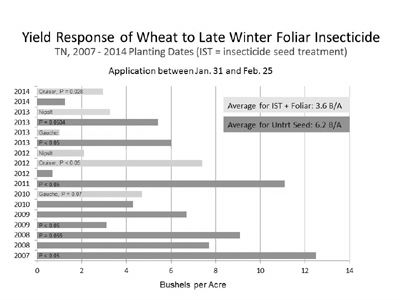Wheat, Aphids, And Barley Yellow Dwarf Virus
DR. SCOTT STEWART
JACKSON, TENN.
It’s the time of year. A late winter insecticide application for the control of aphids in wheat often results in a yield increase. I typically recommend an application before the end of the month. UT data suggests this reduces or delays barley yellow dwarf virus. A late winter insecticide application kills resident aphids before populations begin to increase and spread disease. It may be less valuable if aphid populations were already well established in the fall, as disease transmission may have already occurred.
The amount of potential yield increase varies considerably. Data from 11 trials done in Tennessee since 2007 indicate at average response of about 6.2 bushels/acre on wheat that was not treated with an insecticide seed treatment. The yield response on wheat with an insecticide seed treatment is less.
Typically, pyrethroid insecticides such as Karate/Warrior, Baythroid, Mustang Max and Declare are used at mid-labeled rates. We have some data suggesting that tank mixing with fertilizer applications can work well, you will give up some control if using steamer nozzles. I would prefer a broadcast application. ∆
DR. SCOTT STEWART: IPM Extension Specialist, University of Tennessee
